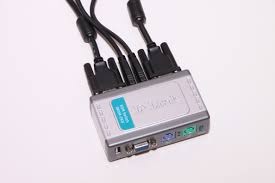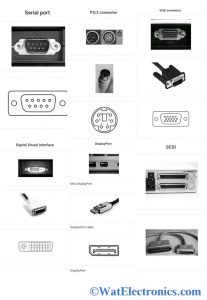In computer hardware and networking, the computer port acts as an interface between the peripheral devices like speakers, printers, webcam, etc, and the computer. The port is a physical point, through which all the peripheral devices can be connected to the computer. This is used to transfer the information or signal between the computer to other devices. (Computer to computer). This article gives a brief note on the computer port and their types.
What is a Port in the Computer/Computer Port?
A port in a computer is referred to as a computer port or communication port or a docking point forms a connection to which all the external peripheral devices are connected to the computer. It is used to transfer the signals from one computer to another computer or from peripheral devices to a computer. The peripheral devices or external devices are mouse, keyboard, monitor, speaker, flash drive, microphone, printer, scanner, etc. Internal ports are used to connect internal devices like hard disks, CD ROM, and DVD drive. Similarly, external ports are used to connect external devices. The computer port diagram is shown below.

Computer Port
These are available in 6-pin, 4-pin, 9-pin, 15-pin, and 25-pin models based on the type of port used for the connection. The computer port diagram is shown below, which includes serial port, ps/2 port, SCSI port, digital visual interface, VGA connector, and display port. These ports are the slots available on the motherboard and backside of the computer.
Types of Computer Ports
These are classified into different types based on the type of communication or protocol. They are listed below.

Computer Ports
Serial Port
it is a serial interface, where all the peripheral devices are connected to a computer using the serial protocol to transfer the data one bit at a time. The serial transmission takes place over a single communication line. The most commonly used serial port is a D-sub connector- DB-25, & DE-9 connectors, which transfers RS-232 signals. It forms a connection between an external modem and mouse of a computer. Available in 9-pin model and 25-pin model. The serial data transfer rate is 115kbps.
Parallel Port
It is a 25-pin parallel port, which connects scanners and printers. It is a parallel communication interface, through which parallel data transmission takes place using multiple communication lines or cable wires. It transmits multiple bits at a time. The data transfer rate is 150kbps. It is an IEEE 1284- Centronics parallel interface port.
SCSI Port
Small Computer System Interface port, which connects printers, hard disks, and tape drives to a single port. The rate of data transmission is higher than the serial port and parallel port.
Parallel SCSI: It uses a Parallel bus for parallel communication.
SAS ( Serial Attached SCSI): It uses the serial bus for serial communication
ISCI
Internet small computer interface system. Used protocol TCP/IP to provide data transmission over LANs, WANs, and any other internet & intranet networks
PS/2 Port
It is a 6-pin DIN connector, also called a mouse port, which can connect the keyboard and mouse of a computer. It is designed by IBM for IBM’s personal computer series -2. For the keyboard, it is coded with purple and for the mouse, it is coded with green color.
USB Port
It is a universal serial bus most widely used for short-distance communication these days. It is a cable connection type, which interfaces between peripheral devices and a computer. Every computer will have a minimum of 2 USB ports. It transfers the data at a speed of 14mbps, which is very faster than the serial port. It was designed in 1997 for industrial standard applications.
These are available in a 4-pin model, in which 1-pin for power supply, 1-pin for ground connection, and 2-pins for data transfer. The length of the USB cable is 5 meters with 4.5mmX11.5mm. We can connect 127 no. of devices to a single computer by using a USB port.
VGA Port
It is a 15-pin video graphic array connector/port, which connects the monitor and video card of a computer. It is usually seen in video cards, computers, and a projector, similar to the serial port or serial connector. IBM introduced the VGA port in 1987. Analog signals are utilized to reduce the resolution. These are the most commonly used and other types of computer ports are listed below.
Modem Port: It connects the modem of a computer to the telephone network or mobile network
Ethernet Port: It connects cables of ethernet to the computer and transfers the data at a speed of 10mbps to 100mbps, which depends on the bandwidth of the network.
Game Port: It connects the joysticks of a video game to the computer. USB ports are used in place of a game port.
Digital Video/Visual Interface Port (DVI Port): It connects the monitor of flat panel LCD type and video graphic devices of a computer.
Sockets: forms connection between microphones, speakers, and sound cards.
Power Connector: 3-pin plug connects power cable of the computer.
Firewire port: connects camcorders and video devices to the computer to transfer a large amount of data at a speed of 400 to 800 Mbps. It is designed by Apple. It is available in 3 types- 4-pin 400 connectors, 6-pin 400 connectors, and 9-pin 800 connector
Computer Port Hardware
Generally, its hardware is generally called an external port or hardware port, or peripheral port, which is in the form of a hole identified on the back of the computer. Allows the access of all the peripheral devices like printers, mouse, keyboard, monitor, speaker, scanner, etc by the computer. Based on the type of connection of the peripheral device to the computer, the computer port hardware slot varies. That means it can be a 5-pin or 4-pin or 3-pin or 9-pin slot or 25-pin slot.
The computer port hardware is of two types, depending on the type of signal transfer. They are,
- Analog port
- Digital port.
Digital ports are serial ports and parallel ports.
After connecting all the ports, the type of transfer, rate of transfer of data is shared from the peripheral device to the computer by handshaking.
It acts as an interface between the external devices and the computer for serial, parallel, and both serial-parallel data transfer.
Functions of Computer Ports
The functions of computer ports are,
- It connects external devices to a computer.
- These are external slots on the motherboard where all the peripheral device (mouse, printer, keyboard, speakers, monitor, microphone, etc) cables are plugged in.
- It acts as an interface or forms a connection between the devices where the flow of information/ data/ signal takes place from the computer to other devices.
- It provides communication between the peripheral devices and computers to transfer the signals very quickly.
- Responsible for serial communication and parallel communication.
Please refer to this link to know more about Pipelining in Computer Architecture MCQs & Computer Networks MCQs
Please refer to this link for Computer Port MCQ
Thus, this is all about an overview of computer ports – definition, diagram, hardware, and functions. Here is a question for you, “What are the advantages of computer ports? “